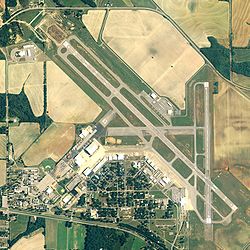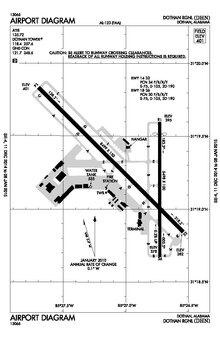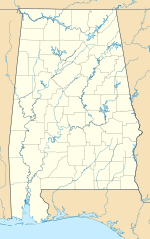Dothan Regional Airport
|
Dothan Regional Airport (former Napier Army Airfield) |
|||||||||||||||
|---|---|---|---|---|---|---|---|---|---|---|---|---|---|---|---|

NAIP aerial image, June 2006
|
|||||||||||||||
| Summary | |||||||||||||||
| Airport type | Public | ||||||||||||||
| Owner | Dothan-Houston County Airport Authority | ||||||||||||||
| Serves | Dothan, Alabama | ||||||||||||||
| Elevation AMSL | 401 ft / 122 m | ||||||||||||||
| Coordinates | 31°19′16″N 085°26′58″W / 31.32111°N 85.44944°WCoordinates: 31°19′16″N 085°26′58″W / 31.32111°N 85.44944°W | ||||||||||||||
| Website | FlyDothan.com | ||||||||||||||
| Maps | |||||||||||||||
 FAA diagram of Dothan Regional |
|||||||||||||||
| Location of airport in Alabama | |||||||||||||||
| Runways | |||||||||||||||
|
|||||||||||||||
| Statistics (2015) | |||||||||||||||
|
|||||||||||||||
|
Source: Federal Aviation Administration
|
|||||||||||||||
| Aircraft operations | 75,440 |
|---|---|
| Based aircraft | 72 |
Dothan Regional Airport (IATA: DHN, ICAO: KDHN, FAA LID: DHN) is a public airport in Dale County, Alabama, United States. It is seven miles northwest of Dothan, a city mostly in Houston County. The airport is owned by the Dothan-Houston County Airport Authority.
It is in the National Plan of Integrated Airport Systems for 2011–2015, which called it a primary commercial service airport (more than 10,000 enplanements per year). As per Federal Aviation Administration records, the airport had 47,859 passenger boardings (enplanements) in calendar year 2008, 42,071 in 2009 and 41,453 in 2010.
Airline service is limited to one regional carrier. Over 50% of its flights are military aviation training operations from nearby Fort Rucker, NAS Whiting Field, and NAS Pensacola, while just under 40% are general aviation.
In 1941 the United States Army Air Corps constructed Napier Field, named in honor of Major Edward L. Napier of Union Springs, Alabama. One of the Army's first flight surgeons, he was killed in the crash of a Fokker D.VII, AS-5382, at McCook Field, Dayton, Ohio, on 15 September 1923. He had been a Medical Corps Officer in World War I and had transferred to the Army Air Corps. He was receiving training as a flight surgeon at the time of his death. The official report states that he was piloting the plane himself and there was a structural failure of a wing.
...
Wikipedia

